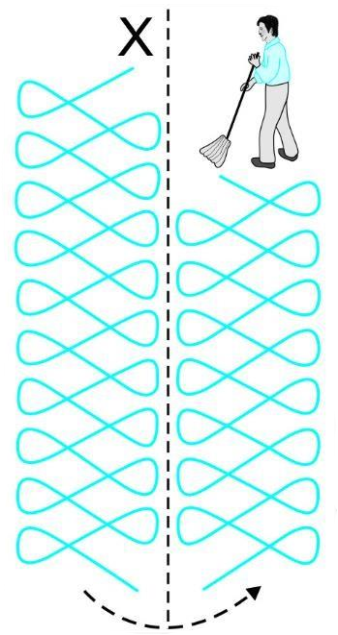This document deals with protocol for cleaning all clinical and non-clinical areas and other objects that an HCW will come in contact with at a clinical facility.
COVID-19 virus can potentially survive in the environment for several hours/days.
Cleaning agents and disinfectants
| COVID isolation room/ screening area | Disinfectant | Contact time | Frequency |
|---|---|---|---|
| High touch surfaces | Hypochlorite 0.5% (wipe) | 10 min | Twice/ shift (4 hourly) |
| Floor | Clean (soap & water)and then Hypochlorite 0.5% (mop) | 10 min | Once/ shift (8 hourly) |
| Wall, ceiling | Hypochlorite 0.5% (wipe) | 10 min | Once daily |
| Linen (used) | Hypochlorite 0.1% | 30 min | As on when |
| Toilet | Clean (soap & water)and then Hypochlorite 0.5% (wash) | 10 min | Twice/ shift (4 hourly) |
| Corridor | Hypochlorite 0.5% (mop) | 10 min | Once / shift (8 hourly) |
| Non-critical equipment (stethoscope, BP cuff, thermometer etc) | Alcohol wipes | After each use | |
| Slippers | Soap and water first and then with Hypochlorite 0.1% (dip) | 10 min | Once /day |
| Termination disinfection | Soap and water followed by 0.5% hypochlorite | 10 min | As on when needed |
| All other non-Corona area (ward, ICU, EMS OPD etc) | Disinfectant | Contact time | Frequency |
|---|---|---|---|
| High touch surfaces | Bacillocid extra 0.25% (wipe) | 10 min | Twice/ shift (4 hourly) |
| Floor | Clean (soap & water)and then Bacillocid extra 0.25% (mop) | 10 min | Once/ shift (8 hourly) |
| Wall, ceiling | Bacillocid extra 0.25% (wipe) | 10 min | Once daily |
| Linen (used) | Hypochlorite 0.1% | 30 min | As on when |
| Toilet |
Clean (soap & water) and then
|
10 min | Twice/ shift (4 hourly) |
| Corridor | Bacillocid extra 0.5% | 10 min | Once / shift (8 hourly) |
| Non-critical equipment (stethoscope, BP cuff, thermometer etc) | Alcohol wipes | After each use | |
| Slippers | Soap and water first and then with Hypochlorite 0.1% (dip) | 10 min | Once /day |
| Termination disinfection | Soap and water followed by Bacillocid extra 0.5% | 10 min | As on when needed |
| Disinfectant concentrations | Dilution protocol |
|---|---|
| Hypochlorite 1% | Readily available in JIPMER |
| Hypochlorite 0.5% | 1Lt of 1% hypochlorite + 1 Lt water |
| Hypochlorite 0.1% | 100ml of 1% hypochlorite + 900 ml water |
| Bacillocid Extra 1% | 10ml in 1Lt |
| Bacillocid Extra 0.5% | 5ml in 1Lt |
| Bacillocid Extra 0.25% | 2.5ml in 1Lt |
| Lysol 7% (phenolic compound) | 15ml Lysol + 1Lt water, or 60ml in 4 Lt |
| Household Bleach Solution | Dilution | Preparation | Chlorine(PPM) |
|---|---|---|---|
| Neat (5%) (5.25 - 6.15%) | None | - | 50000 |
| 0.5% of Sodium Hypochlorite | 1:10 | 1 volume of neat + 9 volumes of cold tap clean water | 5000 |
| 0.05% of Sodium Hypochlorite | 1:100 | 1 volume of neat + 99 volumes of cold tap clean water | 500 |
| 1% of Sodium Hypochlorite | 1:5 | 1 volume of neat + 4 volumes of cold tap clean water | 10000 |
| 0.1 % of Sodium Hypochlorite | 1:50 | 1 volume of neat + 49 volumes of cold tap clean water | 1000 |
| Areas/Items | Agent | Process | Method/Procedure |
|---|---|---|---|
| Stethoscope | Alcohol-based rub/Spirit swab | Cleaning |
|
| BP cuffs & covers | Detergent Hot water | Washing |
|
| Thermometer |
Detergent and Detergent and Alcohol rub Individual thermometer holder |
Cleaning |
|
| Injection and dressing trolley |
Detergent and water Duster Disinfectant (70% alcohol) |
Cleaning |
|
| Mobile phones and landline phones | Alcohol wipes | Front and back |
|
|
Ventilator Monitor Defibrillator USG machine |
Detergent followed by Alcohol (Wettask wipe or Bacilliol-25 spray) |
|
|
| Ventilator tubing | ETO or plasma sterilization | Sterilization |
|
| Ventilator- suction apparatus | Bacillocid extra 1% | Disinfection | Discard the suction fluid as per BMW rule, then immerse in detergent followed by water and finally in Bacillocid extra for 10-12 min |
If Washing machine is there:
Wash at 60-90°C with laundry detergent followed by soaking in 0.1% Sodium Hypochlorite for approximately 30 minutes and dried
If no machine washing is there:
